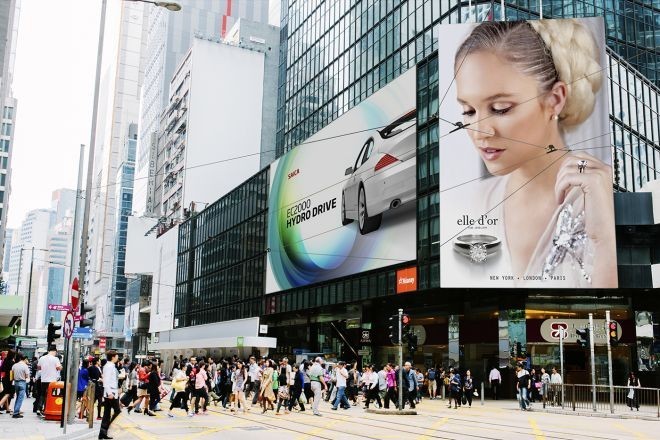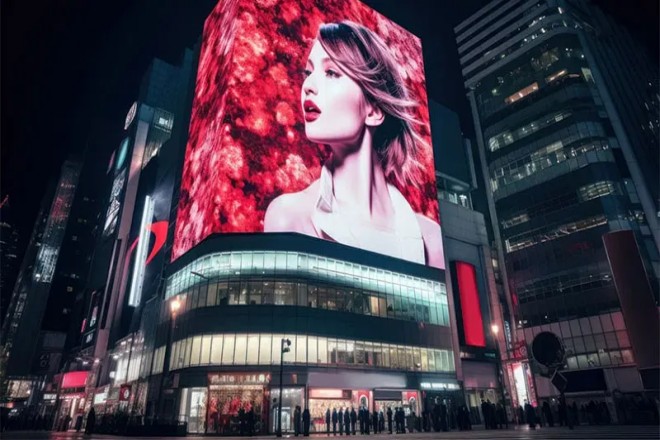序章

In the era of information explosion, LED表示画面, with their unique visual charm, have quickly “established” their position as the “best equipment” for advertising dissemination in more developed cities. But as an advertiser, how can you choose the right LED display screen to place advertisements among so many LED displays?
Step 1: Identify where your audience often appears
When identifying the areas where your audience often appears, you need to conduct a series of detailed analyses and research.
This step is a crucial part of the marketing strategy because it is directly related to whether your message can be effectively conveyed to the target audience.
初め、 you need to conduct an in-depth analysis of the audience. This includes understanding their basic information, such as age, gender, occupation, hobbies, etc., which helps us portray the audience.
For example, if our audience is mainly young students, they may be more inclined to appear on social media, campus activities, or student gatherings.
第二に、 you need to study the daily habits and activity patterns of the audience. This includes where they usually shop, entertain, study or work. By understanding these, you can find the places they often hang out and determine where your marketing information should be placed.
For example, if the audience often shops in a particular ショッピングモール, it will be more effective to advertise or hold promotions in that mall.
加えて, you also need to consider the psychological and behavioral characteristics of the audience. For example, do they have a strong preference for a certain brand or product? Are they easily influenced by a certain type of marketing information?
By understanding this, you can more accurately target your marketing information to make it more in line with the needs and expectations of the audience.
ついに、 based on the above analysis, you can determine the areas where the audience often appears. These areas may be online social media platforms, specific websites or forums; or offline shopping malls, supermarkets, schools, communities and other physical places.
Once these areas are determined, you can develop targeted marketing strategies to ensure that your message can be accurately conveyed to the target audience.
Step 2: Compare the display effects of all LED screens in the selected area before advertising

Before advertising, be sure to pick the LED screen carefully; otherwise, the advertising effect will be greatly reduced.
1). Prepare test content and tools
First, you need to prepare test content for LED displays, including high-contrast images (such as those with clear black and white and strong color contrast), colorful photos (landscapes, people are fine), and some dynamic videos (fast-moving, color gradient, everything is necessary). In this way, you can fully see how capable these LED displays are.
Don’t forget to ensure that the playback conditions of all LED displays, such as 解決 and frame rate, are the same during the test so that a fair comparison can be made.
2). Field investigation and preliminary observation
Next, you have to go to the site in person to see where these LED displays are installed, what size they are, and what the surrounding environment is like, such as whether the light is good and whether there are any obstructions.
Then, look at them during the day and at night to see their brightness, contrast, and color performance. Don’t forget to look at them from all angles to see if the brightness is uneven and the colors are inconsistent.
3). Play the test content and record it in detail
When testing LED displays, be sure to pay attention to recording. For example:
Image clarity: Check if the image is as clear as a mirror, and check if there are jagged edges or blurry areas.
色再現: The color should be accurate and full, without color cast or distortion.
輝度 そして対照的です: Check it both day and night to see if the brightness is sufficient and the contrast is vivid.
ダイナミック効果: The dynamic picture should be smooth, not stuck, and the response speed should be fast.
視野角 パフォーマンス: The brightness should be uniform, and the color should be consistent from all angles.
4). Compare technical specifications
In addition to looking at the actual effect, you also have to compare technical specifications.
解決 と ピクセルピッチ: The higher the resolution, the finer the image; the smaller the pixel pitch, the finer the display effect.
リフレッシュレート and response time: The refresh rate should be high so that the dynamic picture is smooth; the response time should be short so that the audience does not have to wait too long.
輝度 and power consumption: The brightness should be bright enough, but the power consumption should not be too high. Otherwise, the cost will be unbearable in the long run.
5). Practical factors should also be considered
Don’t forget that there are some practical factors that need to be taken into account.
保守性: You have to calculate the maintenance cost and repair cycle so that the display screen will not “go on strike” before the advertisement is put on for a few days.
インストール環境: Outdoor display screens must be waterproof, dustproof, and sun-proof. Otherwise, they will break after a few winds and rain.
Operator service:
If the display screen is managed by the operator, you also have to check the service quality and technical support so that no one will take care of it when there is a problem.
6). Comprehensive evaluation and decision-making
Finally, you have to take out the data and observations recorded earlier and analyze them carefully. You have to have an idea of which display screen performs best and which one has the highest cost-effectiveness. Don’t forget to consider cost-effectiveness, and don’t ignore the cost in pursuit of the best display effect.
Step 3: Evaluate the location and visibility of all LED display screens in the area
1). Traffic flow analysis:
- 現地調査:
First, you have to go to the site in person to see where the LED display screens are installed. Are they located in places with high traffic flow, such as commercial centers, transportation hubs, tourist attractions, etc? These places are crowded with people, and your advertisements will naturally attract more eyeballs.
- データ分析:
If possible, you can also find some traffic data, such as daily average traffic, holiday traffic, etc. These data can help you more accurately determine the exposure rate of the display screen, so as to choose the most suitable location for advertising.
2). Viewing angle and installation height:
- Viewing angle test:
Observe the LED display screen from different angles to see if the advertising content can be seen clearly. Especially for those displays installed on the roadside, you have to make sure that both drivers and pedestrians can see your advertisement at a glance.
- Installation height:
The installation height of the LED display screen is also very particular. If it is too high, pedestrians may have to look up to see it clearly, which is inconvenient; if it is too low, it may be blocked by passing pedestrians or vehicles.
You have to find a height that will not be blocked and can be easily seen by most people. Generally speaking, the center point of the display screen should be flush with or slightly higher than the line of sight of most viewers.
3). Environmental adaptability:
- Light conditions:
The ambient light around the display screen has a great impact on the advertising effect. If it is an outdoor LED display, you have to consider whether the brightness of the display is sufficient when the sun is strong during the day, whether the audience can see the advertising content clearly at night, or when the light is dim.
Can the brightness of the display be automatically adjusted to avoid excessive brightness causing light pollution or affecting the audience’s sight?
- Weather conditions:
Outdoor display screens also have to consider weather factors. For example, whether it has waterproof, dustproof, and sun-proof functions and whether it can work normally in bad weather such as rain, snow, and strong winds.
If it is in the northern region, you must also consider the cold and frost resistance of the display screen to ensure stable operation in low-temperature environments.
4). Additional tips:
- Inspection time period:
The flow of people and light conditions may vary in different time periods. Therefore, it is recommended that you conduct inspections in multiple time periods (such as morning and evening peaks, weekends, holidays, etc.) to obtain more comprehensive data.
- Ask surrounding businesses:
You can ask surrounding businesses or residents to understand their views and use of these displays. Their feedback may provide you with some valuable reference information.
Step 4: For budget and cost-benefit analysis

1). Advertising costs:
- Duration of delivery:
You have to think about how long the advertisement will be delivered. Is it a short-term sprint or a long-term garrison? The cost is different at different times. For example, during peak hours, when there are many people, the cost is naturally high.
During late night hours, when there are few people, the cost is relatively low. You have to choose the most appropriate duration of advertising based on the needs and budget of the advertisement.
- 位置:
location, location, and location! The location of the LED display is a key factor in determining the effectiveness of the advertisement. Display screens in busy business districts are definitely expensive, but the exposure rate is also high.
Display screens in remote areas are cheap, but the exposure rate may not be so good. You have to weigh the pros and cons and find a cost-effective location so that the advertisement can be seen without being too expensive.
- Advertising format:
Advertising format is also an important factor affecting the cost. Static images are cheap, but may not be so attractive; dynamic videos are effective, but the cost is relatively high. You have to choose the most appropriate advertising format based on the content of the advertisement and the preferences of the target audience.
2). Cost-effectiveness evaluation:
- Expected benefits:
Before placing an advertisement, you have to estimate the possible benefits of the advertisement. This benefit can be sales, increased brand awareness, increased number of customers, etc.
You have to estimate this benefit based on factors such as the target audience of the advertisement, the duration of the advertisement, and the location. Don’t forget that this benefit has to be a real number, not just a feeling!
- 料金:
Next, you have to calculate the total cost of advertising. This cost is not just as simple as advertising fees, but also includes production costs such as advertising design and video production, as well as other possible costs such as market research and data analysis. You have to add up all these costs to get a total cost.
- ROI:
Finally, it’s time to calculate the return on investment (ROI). ROI is the expected revenue divided by the total cost multiplied by 100%. The higher this number is, the more cost-effective your advertising is. If the ROI is very low or even negative, then you have to think carefully about whether this advertising is worth it.
結論
In summary, choosing an LED display suitable for advertising is a comprehensive art of consideration, which integrates multiple dimensions such as advertising goals, audience analysis, technical performance, location advantages and cost-effectiveness.
Through careful planning and strategic layout, we can not only enhance the visual impact of advertising, but also deepen the connection between the brand and the audience.
最後に、LEDディスプレイについてさらに詳しく知りたい場合は、 ご連絡ください。
